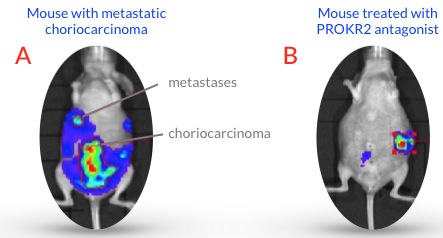Placental choriocarcinoma (CC) is a very aggressive cancer that develops, in women who undergo repeated miscarriages. This cancer still kills a large number of patients, especially in developing countries. The actual proposed anti-tumor chemotherapy of CC is associated with strong toxic side effects. Neither the mechanism of development of a choriocarcinoma, nor its progression is characterized.
Researchers from the laboratory identified the EG-VEGF (Endocrine Gland-derived Vascular Endothelial Growth Factor) placental protein as new factor that controls trophoblast proliferation and invasion, two key events that govern the development of CC and its metastasis towards other organs. EG-VEGF acts
via two receptors, PROKR1 and PROKR2. To demonstrate the involvement of EG-VEGF in the development of CC and search for potential therapy that might interfere with the functions of this protein, the researchers conducted three types of studies. The first is a clinical study involving three centres of reference for trophoblastic diseases: a French centre (Pr. F. Golfier, Hospices Civils de Lyon), a Moroccan centre (Pr. H. Boufettal, Casablanca University Hospital), and a Canadian centre (Pr. R. Slim, McGill University).
This study demonstrated that the levels of EG-VEGF were highly increased in the serum and within the tumors of thechoriocarcinoma patients. The second study, conducted
in vitro and based on 2D and 3D cultures systems of different placental tissues, allowed the characterization of the therapeutic potential of EG-VEGF receptor antagonists. The third approach involved the development of a new CC pre-clinical animal model. This model, recently patented by the CEA was used to demonstrate the therapeutic potential of the two EG-VEGF antagonists
in vivo.
This therapeutic potential has also been patented by the CEA. The new animal model of CC provides evidence that EG-VEGF receptors can be considered as safe therapeutic targets and opens up the prospect of future targeted therapies that will be less toxic than the ones currently used c.

|
| | |
Pregnant mouse with choriocarcinoma and metastases. | | Mouse treated with PROKR2 antagonist. There is a significant decrease in metastases. |